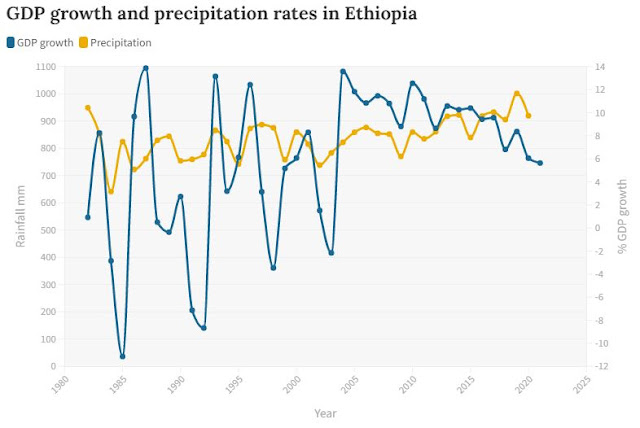What's an economy without water?
📈Reading beyond trend lines
The last blog ended with the the figure below showing precipitation and GDP seeming to have a relationship. The question posed was are African economies reliant on rainfall. The main aim of this blog is to recognise that most African countries agriculture is a large part of the GDP for example 37.57% of Ethiopias GDP constitutes of agriculture however, rainfall cannot be deemed as the single most significant factor causing economic downturns and in fact political climates may be playing a significant role in the economies. The example of Zimbabwe will be used to demonstrate this point.
 |
| Figure 1: Data sourced from The World Bank. Chart made in Flourish. |
GDP as a political tool
The IPCC reported that rainfall plays a significant role in reducing growth in Africa. Whilst rainfall is having impacts on GDP to a certain extent this is being used to cover up for poor governance in Zimbabwe. In 2000 the government of Zimbabwe blamed the economic downturn on drought when in actual fact it was due to poor governance driving up market prices. By analysing the rainfall trends of Zimbabwe the precipitation the year 2000 was relatively minor in context to historical trends. The country also has several groundwater reserves which are already utilised for irrigation which meant the commercial farm sector can endure short, low rainfall periods. Water again is used in a political setting, by using the narrative of low rainfall as the cause of a poor GDP there is the hope that poor governance will go on ignored.
 |
| Figure 2: Displays the influence of political factors on GDP compared to precipitation (Richardson,2007). |
Diversification, the solution to food security in Africa?
Diversifying crops, livestock and irrigation methods and importing can all be ways of diversifying the agricultural sectors however can the approach of crop rotation and diversification help improve the food security for those in African countries.
Farmers may achieve this by having a few livestock as well as crop production or through rotating the crops they are growing to increase productivity. In countries such as Malawi where the agricultural sector is dominated by smallholder maize farming as the main stable crop diversification can not only provide diversity of diet but improve nutrition security. Cultivating several crop species can help manage prices and production risks according to Di Falco and Chavas. This method can also be a means to increase productivity of farms and help farmers meet their consumption needs. This is most common for farmers with the highest diversity on their farms usually owning two units of livestock and growing six different types of crops.
Challenges
1 1) Diversification is best in
certain regions
Diversification works best in areas with 500-1000 mm ofannual rainfall with 17-22% rainfall variability. From the map below it is clear that only
equatorial Africa experiences the amount of rainfall required for optimal
diversification. Most cultivated land falls in the area of 600-700 mm of
rainfall with extended dry seasons occurring more often. Diversification is optimal in countries such
as Rwanda, Burundi and Uganda whereas south Ethiopia and regions in the Sahel
are characterised by low faming diversity one of the reasons being due to the
amount of rainfall leading to one crop such as maize and soy being the dominating crops for agriculture.
 |
| Figure 3: Precipitation rates in Africa. Source. |
2) 2) Diversification and inequality
In previous studies it is highlighted that there are inequalities
in diversifying crop. It is a greater challenge to diversify for small hold
farmers as they do not own large plots of land. There are significant
constraints with this method as more affluent households are more likely to access
better opportunities for diversification with more land means greater possibilities
for growing different crops.
Conclusion
Evidence for diversification does indicate a positive impacts on income, nutrition and food security however these benefits are not happening on a large scale yet to affect majority of small holder farmers. There is also an inherent inequality with food diversification with the poor being hindered by economic barriers. In order for food security to be improved through diversification the programs must be tailored to recognise the subsequent barriers for farmers who own smaller amounts of land with little income generated from their crops.
In the next blog I will discuss the potential of groundwater resources and questioning whether groundwater can be the future of agriculture in Africa.

Comments
Post a Comment